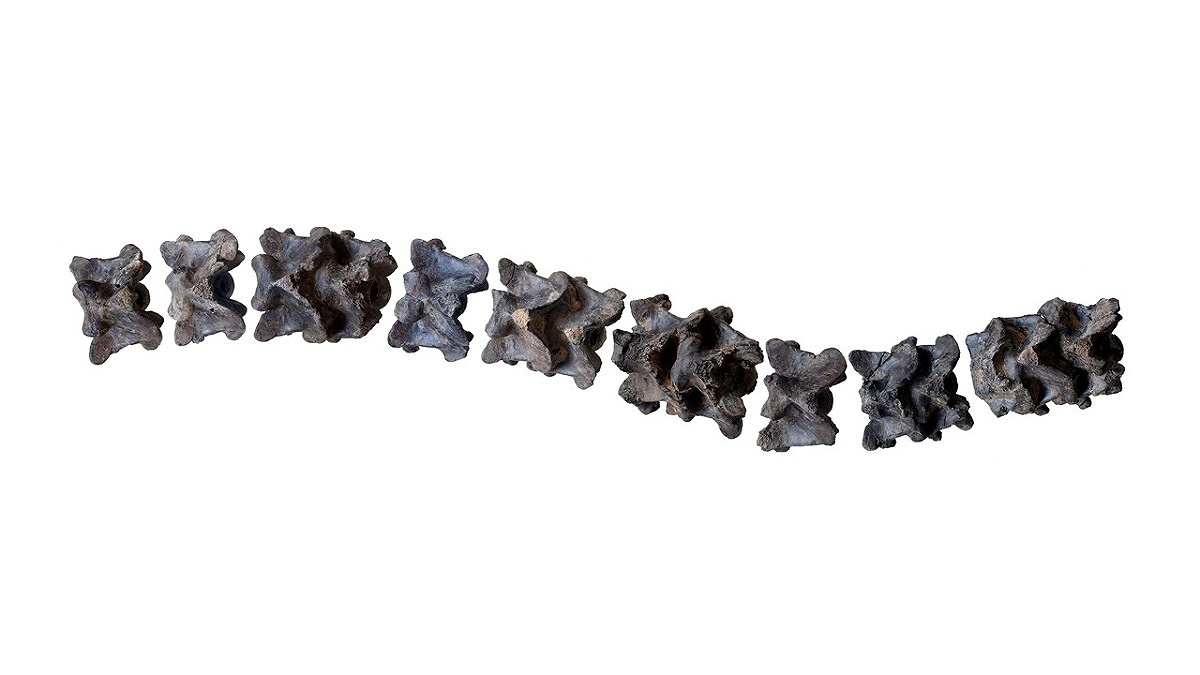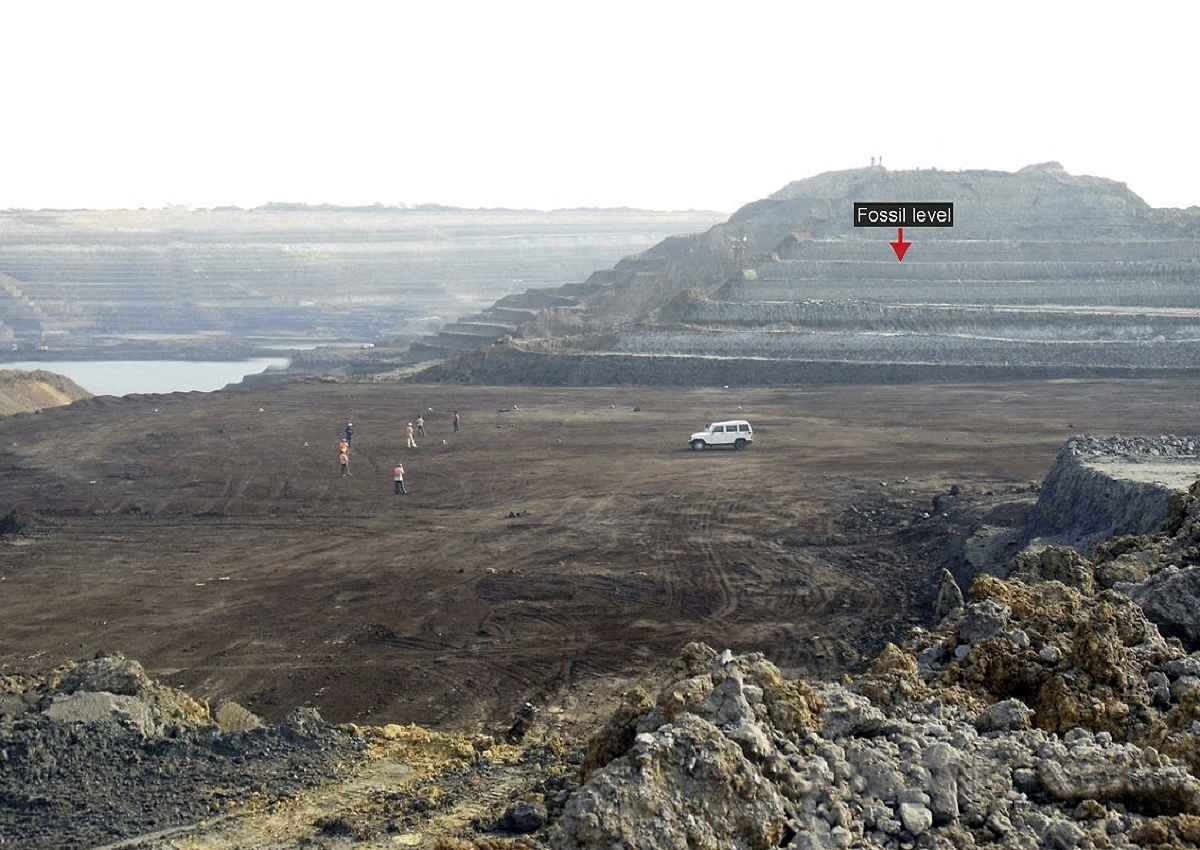
A composite skeleton showing fossil vertebrae representing the trunk region of the prehistoric snake Vasuki indicus is seen in this photo obtained on April 17.
17:34 JST, April 25, 2024
WASHINGTON (Reuters) — Fossil vertebrae unearthed in a lignite mine are the remains of one of the largest snakes that ever lived, a monster estimated at up to 15 meters in length — longer than a T. rex — that prowled the swamps of India around 47 million years ago.
Scientists said on April 18 they have recovered 27 vertebrae from the snake, including a few still in the same position as they would have been when the limbless reptile was alive. They said the snake, which they named Vasuki indicus, would have looked like a modern-day large python and would not have been venomous.
The mine is located in the Panandhro area of the Kutch district in western India’s state of Gujarat. Lignite is the lowest grade of coal.

An undated photo of panoramic view of Panandhro Mine, Kutch, Gujarat, India, shows the fossiliferous level (red arrow) where the remains of the prehistoric snake Vasuki indicus were discovered.
“Considering its large size, Vasuki was a slow-moving ambush predator that would subdue its prey through constriction like anacondas and pythons. This snake lived in a marshy swamp near the coast at a time when global temperatures were higher than today,” said Debajit Datta, a postdoctoral researcher in paleontology at the Indian Institute of Technology Roorkee (IITR) and lead author of the study published in the journal Scientific Reports.
Because of the incomplete nature of the Vasuki remains, the researchers gave an estimated length range of 11-15 meters and a rough estimate of a metric ton in weight.
Vasuki, named after the snake king associated with the Hindu deity Shiva, rivals in size another huge prehistoric snake called Titanoboa, whose fossils were discovered in a coal mine in northern Colombia, as announced in 2009. Titanoboa, estimated at 13 meters long and 1.1 metric tons, lived 58-60 million years ago. The reticulated python is the longest extant snake, sometimes measuring 6-9 meters.
“The estimated body length of Vasuki is comparable to that of Titanoboa, although the vertebrae of Titanoboa are slightly larger than those of Vasuki. However, at this point, we cannot say if Vasuki was more massive or slender compared to Titanoboa,” said paleontologist and study coauthor Sunil Bajpai, a professor at IITR.
These huge snakes lived during the Cenozoic era, which began after the dinosaur age ended 66 million years ago.
The largest-known Tyrannosaurus rex is a specimen named Sue at the Field Museum in Chicago, at 12.3 meters long, though a T. rex would have been more massive than these snakes.
The biggest Vasuki vertebra was around 11.1 centimeters wide. Vasuki appears to have had a broad, cylindrical body perhaps around 44 centimeters wide. The skull was not found.
“Vasuki was a majestic animal,” Datta said. “It may well have been a gentle giant, resting its head on a high porch formed by coiling its massive body for most parts of the day or moving sluggishly through the swamp like an endless train. In some ways it reminds me of [fictional giant snake] Kaa from ‘The Jungle Book.’”
The researchers are not sure what prey Vasuki ate, but considering its size it could have included crocodilians. Other fossils in the area included crocodilians and turtles, as well as fish and two primitive whales, Kutchicetus and Andrewsiphius.
Vasuki was a member of the Madtsoiidae snake family that appeared roughly 90 million years ago but went extinct about 12,000 years ago. These snakes spread from India through southern Eurasia and into north Africa after the Indian subcontinent collided with Eurasia around 50 million years ago, Bajpai said.
This was a dominant snake family during the dinosaur age’s latter stages and into the early Cenozoic before its diversity dropped, Bajpai added.
“Snakes are amazing creatures that often leave us stunned because of their size, agility and deadliness,” Datta said. “People are scared of them as some snakes are venomous and have a fatal bite. But snakes perhaps attack people out of fear rather than with an intent to attack. I believe snakes, like most animals, are peaceful creatures, and an important component of our ecosystem.”
"Science & Nature" POPULAR ARTICLE
-

Genome Study Reveals Milestone in History of Cat Domestication
-

Big Leap in Quest to Get to Bottom of Climate Ice Mystery
-

Japan Set to Participate in EU’s R&D Framework, Aims to Boost Cooperation in Tech, Energy
-

Paws on Parade: Nairobi’s Dogs Dazzle at ‘Pawchella’
-

Japan’s H3 Rocket Failed in Latest Launch, Says Official
JN ACCESS RANKING
-

Tokyo Economic Security Forum to Hold Inaugural Meeting Amid Tense Global Environment
-

Keidanren Chairman Yoshinobu Tsutsui Visits Kashiwazaki-Kariwa Nuclear Power Plant; Inspects New Emergency Safety System
-

Imports of Rare Earths from China Facing Delays, May Be Caused by Deterioration of Japan-China Relations
-

University of Tokyo Professor Discusses Japanese Economic Security in Interview Ahead of Forum
-

Japan Pulls out of Vietnam Nuclear Project, Complicating Hanoi’s Power Plans






















